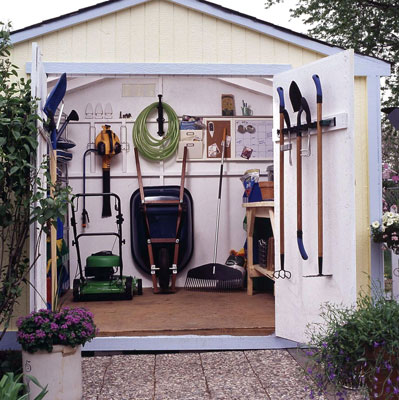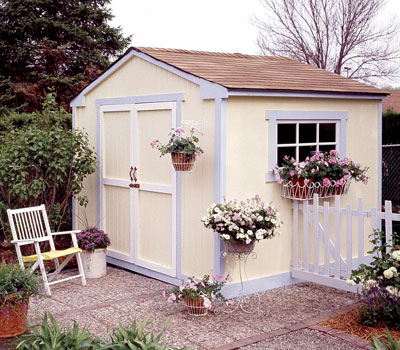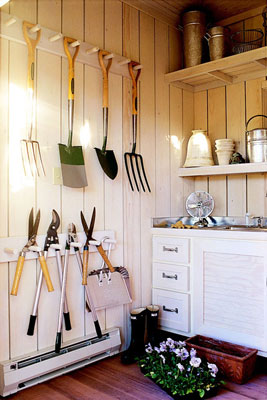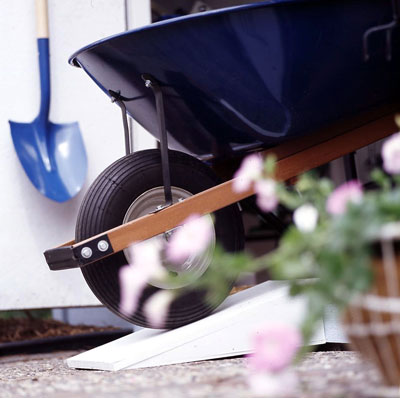Plan the Perfect Garden Shed

With a little planning, you can build the garden shed of your dreams or turn a ho-hum shed into a work of garden architecture. The garden experts at Better Homes and Gardens® can help you plan that new shed or help you get the most out of your current one. Just think of how a fresh coat of paint, charming hanging baskets, a picture window, and updated door handles can bring your old shed back to life or give a new prefabricated shed added value.
The Basics
A garden shed allows you to store all your equipment and supplies in one location and provides a small workplace for potting containers or cleaning up hand tools. Garden sheds can be almost any size or style. A garden shed is essential especially for gardeners without a garage or basement, and it can be an attractive addition to the yard. A hardworking garden shed incorporates storage solutions such as hooks, baskets and bins, shelves, and a workbench. Storing tools in an orderly manner makes gardening easier and prolongs the life of the tools.

Determine Your Needs
Decide the purpose you want the shed to serve. If you want it to hold all your tools, make a list of every tool you own and note whether it is best for the tool – and most convenient for you – to be stored on a shelf, hung on the wall, or set on the floor. Include all power equipment, such as mowers, trimmers, tillers, and blowers that require a lot of space.
Next, ask yourself if you want to do any work inside the shed. Is it where you will repot plants? Do you want a table and vise for sharpening tools? Will you be doing plant propagation or soil mixing? Will you be building anything?
Convert your answers into dimensions: Add up the square footage of floor space and estimate the amount of wall and shelf space required. This gives you a starting point for estimating the size of the structure. Sketch a floor plan to see what kind of footprint the structure will require. Start thinking about the location of the shed, which may limit its shape. Sketch the wall plans to show how much wall space you’ll need for tools and shelf space.

Choose a Style
The choice of styles for a garden shed is almost limitless. Be creative; convert a utility shed, old gazebo, or other structure into a garden shed.
A quick and easy way to get the structure you need is to purchase a prefabricated shed or utility building and dress it up. Cut a window or two into the wall of the shed, paint it to blend in with the rest of the garden, and add a window box. Applying lath to the surface can be a quick and inexpensive way to add charm.
Select a Location
There are several practical issues involved in deciding where to put the shed. It should be convenient to gardening activities that involve use of the tools and other equipment that is stored in the shed. It should be near utilities. Whether or not the utilities are actually connected to the shed, it is handy to have a hose nearby for rising off tools. If the shed is unattractive, you may want to tuck it out of sight.
More Handy Planning Tips

Use the Walls
Using the walls optimizes the space and allows you to see your tools at a glance. A wide range of devices are available for hanging tools on the walls – from specialty tool clips to a standard perforated board with metal hangers. You can also use coat or funky hat hangers that can often be found at garage sales.
Add Power or Water
Electricity allows you to have lights in the shed to find or put away tools at dusk or on a dark day. It also allows you to have outlets for a fan (or heater in cool weather), electrical devices to sharpen or repair your tools, or power tools. A sink is handy for cleanup, mixing solutions, and drawing water for fresh-cut flowers.
Install a Phone Line
A phone can keep you in touch with the rest of the world while you engage in your favorite pastime.
Secure a Lockable Area
It may not be necessary for the entire shed to be locked, but there should be at least one area that can be secured. Use it to store dangerous (or expensive) tools as well as any chemicals.
Ensure Adequate Ventilation
Check with the local extension service for regulations about chemical storage. Ventilation is a safety essential, especially in an area where chemicals are stored. Even if you don’t plan to store chemicals, good air circulation makes the shed comfortable.

Decorate the Outside
If the shed is visible from a public area, invest in a coat of paint and dress it up with some flowers, a mural, or a garden plaque. Or make a decoration of old garden tools mounted on the wall above the door. This shed has sunny yellow paint and sky blue trim to create an inviting look while protecting the shed from the elements.

Ramp It Up (and Down)
Make storing anything with wheels an easier ride by using a portable ramp to get in and out of the shed. We used a couple of scrap 2x4s and a piece of ½-inch plywood to create a ramp high enough to wheel right into the shed and small enough to store easily when not in use.

Shed a Little Light
Too often sheds have tiny windows – or none at all. Add charm and a source of light for the shed’s interior by installing an inexpensive, off-the-shelf window. A few studs were all that was needed to build a frame for it.

Getting Organized
Outfitting your backyard storage space starts with a quick survey of your stuff. Group items by the way they would be best stored, and then assess your needs. For example, the number of long-handle tools you have will determine the kind of storage device you’ll need. While you’re at it, get rid of tools you haven’t used in years. (Do you really need six dandelion diggers?) Peruse garage sales for a cabinet or cupboard to store small items. Basic open metal shelves work well for most of your needs. Adjustable shelves give flexibility to match shelf height to tools and other supplies.

Mutual Attraction
Mechanics have long taken advantage of magnetic bars to hold and organize their tools, and the strips work just as well for metal garden tools. Choose a bar with a magnet strong enough to hold the weight of your tools and you’ll always have them within reach.

Taking Care of Business
Keep a calendar of landscaping activities and you won’t have to guess when you last fertilized the lawn. This one is metal, creating a convenient place to secure plant tags, seed packets, and small parts with magnetic holders.
So get planning that garden shed of your dreams. It may take a little time but once completed, you’ll enjoy the extra effort for many years to come.
© 2008 Meredith Corporation